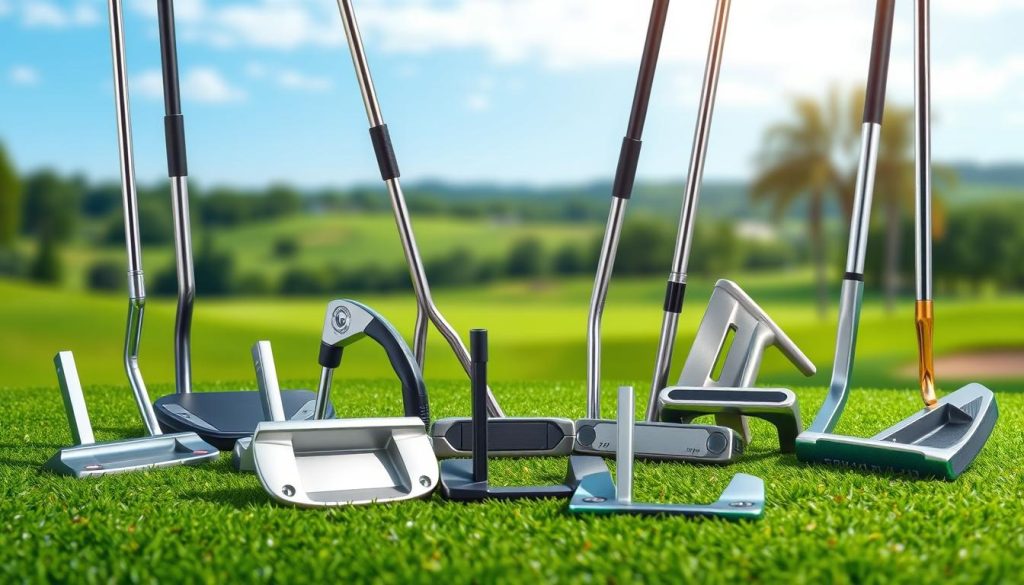Want to improve your golf game? The secret is in your putting technique. This guide will show you how to perfect your putting stroke. It will enhance your golf skills and boost your game.
Face-on putting is a simple yet effective method. It makes it easier to aim your putter. With practice, especially on short putts, you’ll see your scores drop.
Now, let’s explore the basics of improving your putting stroke. We’ll look at techniques used by pros like Brad Faxon and Tiger Woods. You’ll learn about grip pressure, stance, and more. This will help you develop a stroke that feels natural and consistent.
Key Takeaways
- Face-on putting simplifies alignment and improves accuracy
- Practice putts within 10 feet to reduce three-putts
- Maintain a 2:1 backswing to downswing ratio for consistent tempo
- Use a light grip pressure for a freer putter head swing
- Experiment with stance and alignment for optimal performance
- Utilize visualization techniques to enhance putting skills
- Focus on feel and instinct rather than rigid mechanics
Understanding Basic Putting Stroke Mechanics
Mastering the basics of putting is key to bettering your golf game. Let’s dive into the essential parts of putting stroke mechanics. This will help you do better on the green.
Natural Body Alignment
Getting your body right is crucial for a steady putting stroke. Stand with your feet shoulder-width apart, knees slightly bent, and eyes over the ball. This stance helps you stay balanced and move smoothly.
Grip Pressure and Control
Your grip on the putter is very important for a consistent stroke. Hold the putter lightly, using your palms and fingers. This lets you feel and control the putter better. Try out different grip styles to see what suits you best.
Putter Face Orientation
Aligning your putter correctly is key for accuracy. Make sure the putter face is square to your target line at address. This ensures the ball goes where you want it to. Use alignment aids on your putter to get better at this.
| Element | Importance | Tips |
|---|---|---|
| Body Alignment | High | Keep eyes over ball, feet shoulder-width apart |
| Grip Pressure | Medium | Light pressure, use palms and fingers |
| Putter Face | High | Square to target line, use alignment aids |
By focusing on these golf basics, you’ll get a more reliable putting stroke. Remember, practice is essential to make these mechanics second nature. This will improve your game on the green.
The Science Behind Wrist Movement in Putting
Wrist mechanics are key in putting. Knowing how wrists move can make your putting better. Let’s look at the important parts of wrist action in putting.
Extension and Flexion Patterns
How you extend and flex your wrists affects the ball’s loft and launch. A slight forward press at the start can lower the loft. Keeping your wrists neutral helps you hit the ball consistently.
Practice keeping your wrist stable during your stroke. This improves how the ball impacts the ground.
Rotation Dynamics
Wrist rotation changes the putter face angle at impact. Too much rotation can cause the ball to veer off course. Try to reduce wrist rotation to hit the ball straighter.
Some wrist rotation is okay. It helps your stroke feel smooth and natural.
Impact Position Consistency
Having a consistent impact position is crucial for better putting. Work on repeating your wrist patterns. This makes your stroke more consistent.
It’s not about keeping your wrists completely still. But, a stable wrist position at impact leads to more reliable results.
| Wrist Action | Effect on Putt | Recommended Approach |
|---|---|---|
| Extension | Increases loft | Maintain neutral position |
| Flexion | Decreases loft | Slight forward press |
| Rotation | Affects face angle | Minimize rotation |
By paying attention to wrist movement, you can improve your putting. Small changes in wrist mechanics can make a big difference in your game.
Face-On Putting Technique Analysis
Face-on putting, also known as side saddle putting, is becoming more popular. It’s seen as an alternative to traditional putting methods. This technique makes aligning easier and helps in keeping the stroke straight, which can improve your accuracy.
In side saddle putting, you face the target with the putter on your side. This stance makes aligning easier because your eyes are right over the target line. Many golfers find it helps them judge distance and line better.
One big plus of face-on putting is that it simplifies your stroke. It reduces wrist movement, leading to more consistent contact and better control over distance. This method works well for short putts, where precision is key.
| Putting Method | Alignment | Stroke Type | Effective Range |
|---|---|---|---|
| Side Saddle | Direct target view | Straight back-and-through | Within 20 feet |
| Traditional | Side-on view | Varied (arc or straight) | All distances |
While side saddle putting can be a game-changer for some, it’s not for everyone. It’s best to try this technique for putts within 20 feet. For longer putts, traditional methods might be better. Remember, practice is essential to master face-on putting and see if it fits your game.
Putting Stroke Optimization Guide
Improving your putting setup and stroke is crucial for better scores. This guide will help you refine your technique. You’ll learn how to achieve consistent impact and control the putter face.
Setup Fundamentals
Your putting setup is the base of a good stroke. Stand with your feet shoulder-width apart and eyes over the ball. Hold the putter lightly to keep control and feel.
Align your shoulders parallel to your target line. This improves your accuracy.
Stroke Path Control
Work on a smooth, pendulum-like motion for your putter path. Use alignment aids to develop a consistent stroke. The Pyramid iCOR Putter, with its extra weight, helps engage your arms and shoulders.
Impact Position Management
Getting solid impact is key for distance control. Use a putting mirror to check your face angle at impact. Place tees on the green to guide your putter path.
Ensure centered contact. Remember, the direction of the putter face at impact affects the ball’s path.
- Practice from 5-6 feet initially
- Align shoulders with mirror lines
- Use tees to limit backswing length
- Focus on straight-back, straight-through motion
Regular practice will build muscle memory for consistent strokes. Remember, PGA Tour players only make half their putts from 8 feet. So, be patient and persistent to improve on the greens.
Distance Control and Lag Putting Mastery
Mastering lag putting and distance control is key to lowering your scores. Green reading is crucial, especially for uphill and downhill putts. Low to mid handicap players often struggle with accurate green reading, highlighting the need for focused practice.
To improve your lag putting, try these exercises:
- Practice long-distance putting challenges
- Focus on getting the ball within a three-foot circle around the hole
- Experiment with different speeds and breaks
Speed management is critical for short putts. Many golfers tend to decelerate on these shots, leading to inconsistency. Work on maintaining a smooth, confident stroke for all putt lengths. Remember to assess the pace of the greens before each putt, as speeds can vary throughout the day.
Tracking your putting performance can reveal valuable insights. Pay attention to your success rates at different distances, not just total putts. This data can help you identify areas for improvement in your long-distance putting and overall green reading skills.
| Putt Length | Success Rate | Focus Area |
|---|---|---|
| 0-3 feet | 95% | Confidence and consistency |
| 3-10 feet | 50% | Speed control and green reading |
| 10+ feet | 10% | Lag putting and distance control |
Consider using training aids like alignment sticks or a putting mirror to refine your stroke mechanics. These tools can help you develop a more consistent putting stroke, essential for both short putts and long-distance lag putts.
Equipment Selection for Optimal Putting
Choosing the right golf equipment is crucial for better putting. The type of putter you use can greatly improve your game. Let’s look at how different putters, grips, and custom fittings can help your putting skills.
Putter Types and Their Effects
There are two main types of putters: blade and mallet. Blade putters are traditional and good for straight strokes. Mallet putters have a bigger head and help with alignment.
New putter technology includes grooved faces. These reduce skidding and help the ball roll true.

Grip Styles and Selection
Grip types are important for your putting stroke. You can choose from conventional, cross-handed, or claw grips. Each grip affects your wrist movement and consistency.
Try different grips to find what works best for you. This will help you perform better.
Custom Fitting Considerations
Custom fitting is key for great putting. Things like shaft length, lie angle, and grip size matter a lot. Most players do well with a 4-degree static loft.
A professional fitting can help you find the perfect putter. It will match your style and body.
| Fitting Factor | Impact on Putting |
|---|---|
| Shaft Length | Affects posture and eye position over the ball |
| Lie Angle | Influences putter face alignment at impact |
| Grip Size | Affects wrist action and stroke consistency |
The best putter feels right in your hands. It should match your stroke. Experiment with different putters and grips to find your perfect match.
With the right equipment and practice, you’ll improve your putting. You’ll be sinking more putts soon.
Advanced Putting Stroke Patterns
Mastering advanced putting patterns is key to improving your game. Even in straight-back-straight-through strokes, a subtle arc exists due to natural body movements. Understanding this nuance is crucial for golfers aiming to elevate their game.
Consistent rotation patterns play a vital role in putting success. The putter face should open slightly on the backswing and close through impact. This rotation helps maintain the proper stroke path and face angle at impact, leading to improved stroke consistency.
To refine your putting stroke, consider using the Pro Path Putting Mirror. This tool features three main components: the shoulder alignment line, target line, and path curve. Start practicing from about 5 to 6 feet from the hole to develop muscle memory for a smoother stroke.
Fine-tune your technique by setting tees for centered contact. Place them narrow enough to allow the putter to pass through without hitting them. Position an additional tee at the back of the mirror to control backswing length, addressing common issues like over-swinging.
Advanced techniques include:
- Aligning shoulders and club face with mirror lines for enhanced accuracy
- Using tees in conjunction with the mirror to refine stroke length and direction
- Practicing different grip styles (traditional, claw, reverse) to find your optimal technique
- Mastering distance control to avoid three-putts
Regular practice with these advanced putting patterns will embed muscle memory, leading to more consistent and precise putts on the green. Remember, small adjustments based on immediate feedback can result in significant improvements in your putting accuracy and overall performance.
Mental Approach to Putting Excellence
Mastering the mental game is key for putting well. A strong mindset boosts your confidence and helps you handle pressure. Let’s look at some techniques to improve your mental game in putting.
Visualization Techniques
Visualization is a strong tool in golf. Imagine the ball smoothly going into the hole before each putt. This mental picture boosts your confidence and stroke.
Studies show that visualizing successful putts can increase your success by 15% during play.

Pre-shot Routine Development
A consistent pre-shot routine is vital for success. Create a routine that includes reading the green and choosing your aim. Also, include practice strokes.
Stick to this routine for every putt, no matter the situation. Golfers who do this well achieve up to 20% more successful putts.
Pressure Management
Managing pressure is crucial for putting well. Practice breathing to stay calm under stress. Focus on the process, not just the outcome.
Try practicing with a smaller hole to improve your feel and accuracy. This can boost your accuracy by up to 25% when you go back to a standard hole.
Remember, the mental game in putting is as important as the physical skills. By using visualization, a solid routine, and managing pressure, you can greatly improve your putting and golf game.
Common Putting Stroke Errors and Solutions
Putting mistakes can ruin a good game. Knowing common errors and how to fix them can greatly improve your putting. Let’s look at some key strategies to better your technique.
One common mistake is moving your wrists too much. This can cause your putts to go off course and not travel far enough. To fix this, keep your wrists steady during your stroke. Use a putting aid like the GP Putter ($329) to help you maintain the right wrist alignment.
Proper face rotation is also key. Many golfers either turn the putter face too much or not enough, leading to missed putts. Use alignment sticks and tees to set up a drill. This will help you aim better and hit the ball square with the putter face.
It’s important to analyze your errors to improve. Use video or wrist motion sensors to spot small flaws. Even top golfers can vary in distance by 40% at 8 feet. By paying attention to these details and practicing, you can master putting.
FAQ
What is the face-on putting technique?
How important is wrist movement in putting?
What are the key elements of basic putting stroke mechanics?
How can I improve my lag putting skills?
What should I consider when selecting a putter?
How can I develop a better mental approach to putting?
What are some common putting errors and how can I correct them?
How can I optimize my putting stroke?
What is the importance of practice in putting?
Are there any therapeutic exercises that can help improve my putting stroke?
Source Links
- https://skillest.com/blog/putting-like-brad-faxon-tips-to-improve-your-putting-stroke/
- https://golfstateofmind.com/the-art-of-putting-a-pure-mental-game/
- https://golfinsideruk.com/putting-technique-the-putting-stroke-explained/
- https://face-on-putting.com/basic-setup/
- https://skillest.com/blog/master-the-art-of-golf-putting-a-comprehensive-guide-for-beginners/
- https://skillest.com/blog/the-science-behind-the-putter-grip-on-driver-how-grip-design-affects-performance/
- https://pmc.ncbi.nlm.nih.gov/articles/PMC3888943/
- https://truespecgolf.com/blog/2017/05/02/putter-fitting-101/
- https://rotaryswing.com/golf-instruction/putting/release-putter-face
- https://hackmotion.com/wrist-action-in-putting/
- https://www.pgaplay.co.uk/learn/the-definitive-guide-to-mastering-the-art-of-putting/
- https://practical-golf.com/putting-tips
- https://pyramidgolf.com/blogs/news/top-10-putting-stroke-tips-for-a-smooth-steady-roll
- https://back2basics.golf/blogs/news/improve-your-putting-with-the-pro-path-putting-mirror?srsltid=AfmBOopo5qPTeU3btlGTaqkVe9uC39tAiMUrhn4YQ24RhAWcipImHIdJ
- https://hackmotion.com/best-putting-tips/
- https://www.shipsticks.com/blog/how-to-improve-your-putting-skills-proven-techniques/
- https://palmbirdputtergrips.com/how-to-improve-putting-consistency-and-performance/
- https://putterhead.com/blogs/news/golf-gear-galore-a-comprehensive-guide-to-equipment-selection-and-maintenance?srsltid=AfmBOorSe3mhMmsGRtNw3Fa_zcgpVr4yLS2t_mund2aYyewqnMFmaRnU
- https://back2basics.golf/blogs/news/improve-your-putting-with-the-pro-path-putting-mirror?srsltid=AfmBOoq8HDzRbDaTbfigE-PRi4mBkBmTax48ZOtQ-ryBcx8bnl6NKUm5
- https://justgolfstuff.ca/blogs/guide/how-to-put?srsltid=AfmBOoqFbpFG6sfwJzh9oXKPA94k15jfUsMjtphX4xsrRis7duaOdUIb
- https://golfstateofmind.com/my-top-ten-mental-game-putting-tips/
- https://www.goodreads.com/book/show/150383770
- https://www.golfpsych.com/mental-pre-shot-routine/
- https://golf.com/instruction/putting/struggle-putting-aim-intimidating-drill-jackson-koert/
- https://side-saddle-putting.com/video-basic-setup-for-the-side-saddle-putting-stroke/?srsltid=AfmBOorkIhj9y12QZOibRTQadDpiobISRhgllYwtGHN0ul08oGb9jKwP


